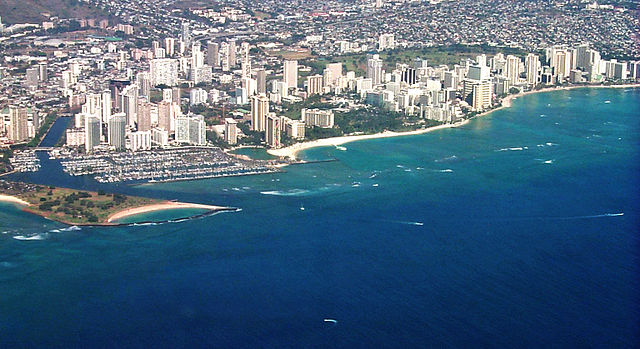
HONOLULU — The fishing vessel that ran aground just off pristine Waikiki beaches more than a month ago is being prepared for removal, possibly by the end of the month.
Crews are working to seal holes in the 79-foot (24-meter) Pacific Paradise, remove sheets of metal to make it lighter, and weld supports to strengthen towing points.
A helicopter hoisted 16 sheets of metal from the boat Sunday in a bid to remove weight so it can be floated again.
“This is vital step in removing weight and recovering the necessary buoyancy to refloat the Pacific Paradise,” said Coast Guard Lt. Will Cotta of the Salvage Engineering Response Team in a statement.
The boat crashed into the reef just before midnight on Oct. 10 with an American captain and 19 foreign workers onboard. No one aboard the vessel called for help when the boat ran aground. Witnesses called the Coast Guard who worked with local fire officials to rescue the men.
The U.S. Coast Guard said water tests show no fuel or oil around the boat, but a visible sheen was seen earlier this month. Swimmers also reported smelling and feeling the fuel in the water.
Water tests were previously being conducted twice a week, but last week officials began testing the water daily in part because of concerns from the Waikiki Aquarium, which is near the crash site and pumps seawater into its tanks.
Gwen Lentes, the aquarium’s curator of live exhibits, told The Associated Press on Monday that the seawater is primarily for their endangered Hawaiian monk seal habitat, though it does supply water to some interior tanks as well.
The aquarium was concerned with the initial response to the wreck and said that twice-weekly water testing was insufficient. If there were pollutants in the water, the aquarium would have had to shut down their water intake immediately to protect the animals.
“The communication wasn’t there, and it wasn’t sufficient,” Lentes said.
Now, however, the aquarium is getting daily reports from the Coast Guard and is satisfied with the increased water testing.
Since meeting with the regional commander of the Coast Guard about a week and a half ago, “they have done like a 180, and the communication is what I would have hoped for from the very beginning,” Lentes said. “If you don’t communicate to us, I can’t shut down the water. If you do communicate to us, then I can and we can prevent this whole thing.”
The vessel was not on a fishing trip when the crash happened. It was transporting foreign workers from Pacific island nations and Southeast Asia to work in the commercial fishing fleet based in Hawaii.
The workers do not have visas and cannot enter the United States, but a loophole in federal law allows them to work in the U.S. Pacific fleet.
The men are not covered by U.S. labour laws and a 2016 Associated Press investigation revealed many of the foreign workers are paid a fraction of what other U.S. fishing crews make. The men are confined to their boats for the duration of their contracts, often a year or two at a time.
Days after the wreck, the vessel caught fire as a salvage team was working on the deck. The fire caused extensive damage, slowed the removal of the vessel and allowed diesel fuel and other oils to enter the water.
Coast Guard officials hope the boat will be removed by the end of November. It will be towed out to sea and sunk at a site approved by the U.S. Environmental Protection Agency.